White and blue birds are found in hundreds of thousands across North America. These types of birds are seen both East and West of The Rocky Mountains as well as in the Southern United States.
Much of their range is subject to seasonal changes as some of the most common migrating birds of North America are blue and white.
Found across various habitats from coastlines to canyons, the following species of white and blue birds have stable numbers and are often seen in North America.
Table of Contents
1. Blue Jay
Blue Jays (Cyanocitta cristata) are one of the most common blue and white birds in North America.
Inhabiting the Eastern parts of the continent, these birds are found across different types of forests as well as in urban areas.
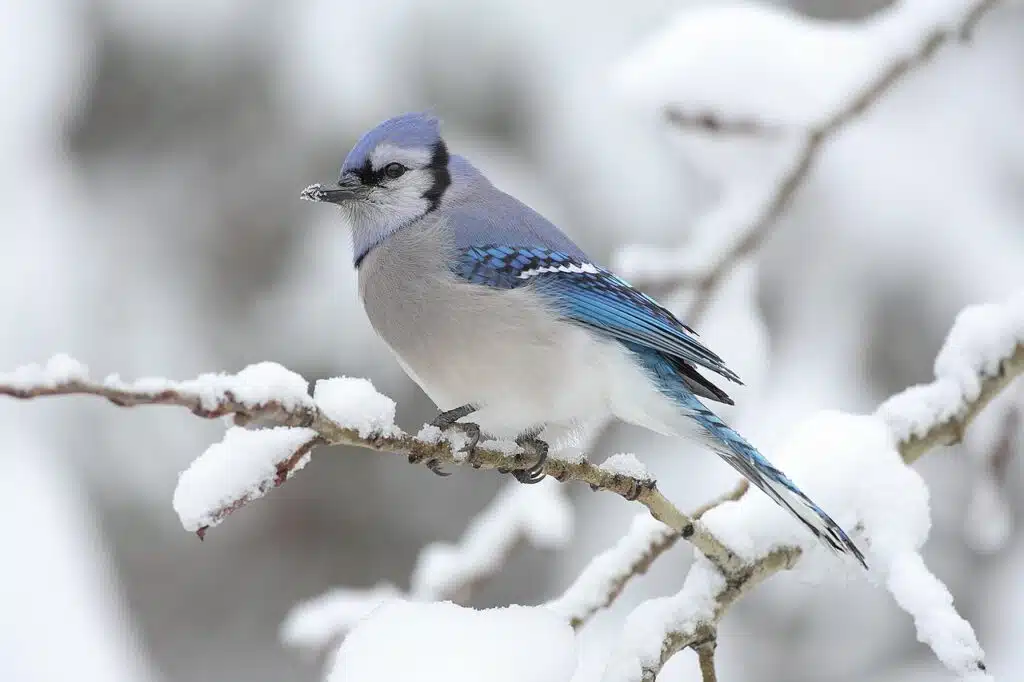
Its chest, face, and belly are white. The rest of its plumage features various shades of bright blue.
A blue crest and a black neckband are among its most distinctive traits.
Blue Jays also have blue wings with bright blue sections and a bright blue tail.
Black bars are further distinguished on the wings as well as on its tail.
The Northern Blue Jay may show duller blue plumage as its blue-gray crest and back areas may be slightly different from its subspecies in the South.
While a slow-paced bird, Blue Jays are known to be aggressive and even beneficial to other birds.
They are known for their loud vocalizations in the presence of various predators. These vocalizations act as warning signals to other Blue Jays or to birds of other species.
Distribution – Eastern North America
2. Eastern Bluebird
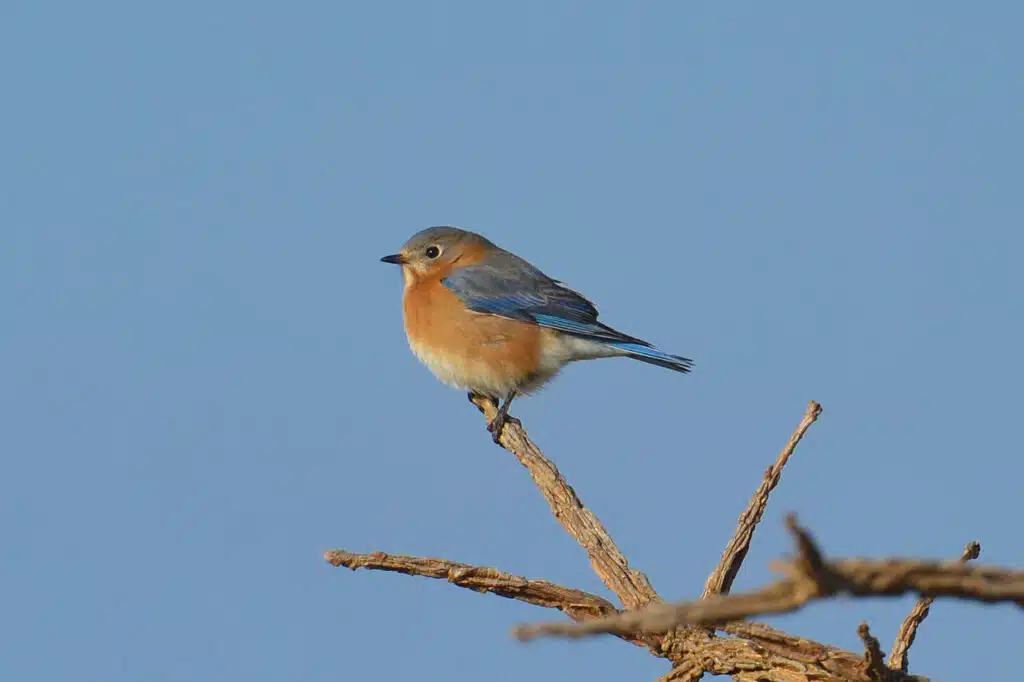
Eastern Bluebirds (Sialia sialis) live in a widespread territory East of The Rocky Mountains.
They inhabit open land in the Eastern US and Canada, with a considerable presence in Mexico.
Birds of the species are among the most common blue species in these parts of North and Central America.
They have a blue crest, blue wings, and blue tails. The blue nuance of the species is generally darker than the nuance of the Blue Jays.
Brown-red nuances are specific to the breast while the underparts of the birds are almost pure white.
Blue coloring marks the species at different life stages as even Eastern Bluebird eggs are blue.
These birds are known to be aggressive, particularly in the breeding season. This is the time when they show territoriality over their feeding range.
Eastern bluebirds returning from their Texas and Northeastern Mexico overwintering range are among the first birds to announce the coming of spring.
Distribution – Eastern Canada, Eastern US, Mexico
3. California Scrub-Jay
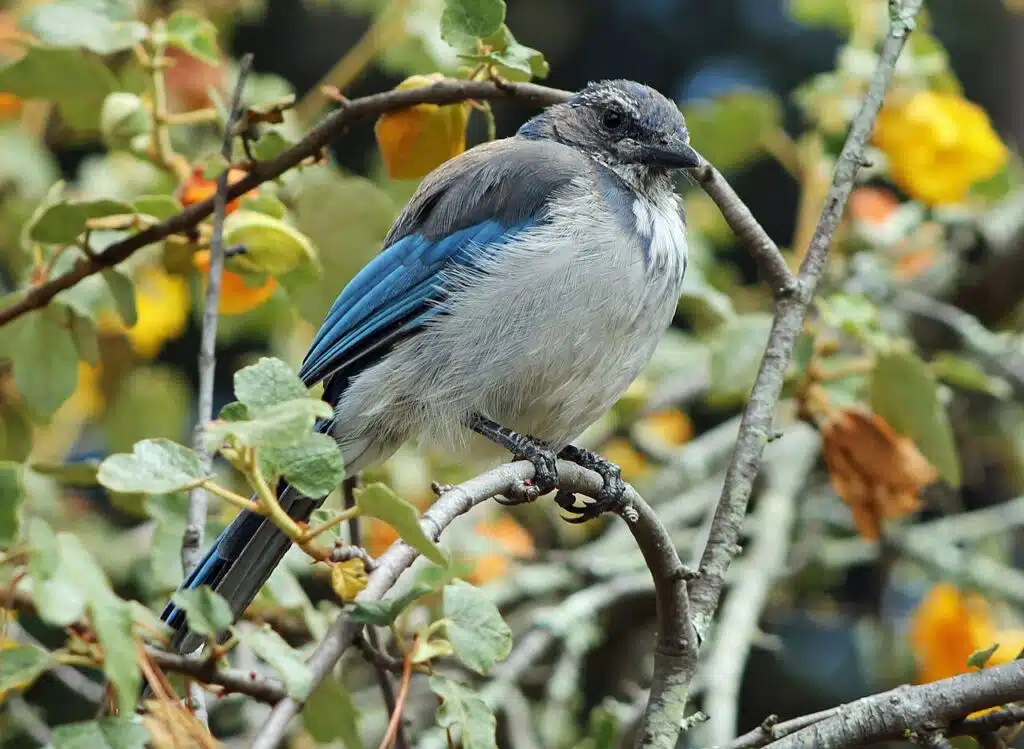
Blue and gray colors dominate the appearance of California Scrub-Jay (Aphelocoma californica). This is a species with a considerable presence in California, Oregon, and Washington State.
Additionally, California Scrub-Jays are also present in Baja California.
Known for its distinct flight pattern in which it flaps its wings quickly to then glide, this species is dominated by a bright blue color.
Its coloring has gray undertones, specific to royal blue. The bird has a blue head, back, wings, and a long blue tail.
This is a species with dark gray markings on the back and bright grey ventral plumage.
White areas are seen on its upper chest and neck, together with a fine white line just above its eyes which additionally feature gray rims.
These birds are further known for their excellent memory. They rely on good memory to store foods around various scattered areas which they can visit as needed.
They store foods in small packs known as caches. Up to several hundred caches can be scattered for later consumption by a single California Scrub-Jay.
Apart from their blue and white nuances, these birds are known to have a large brain compared to their size which helps with their excellent memory.
Distribution – Western United States
4. Western Bluebird
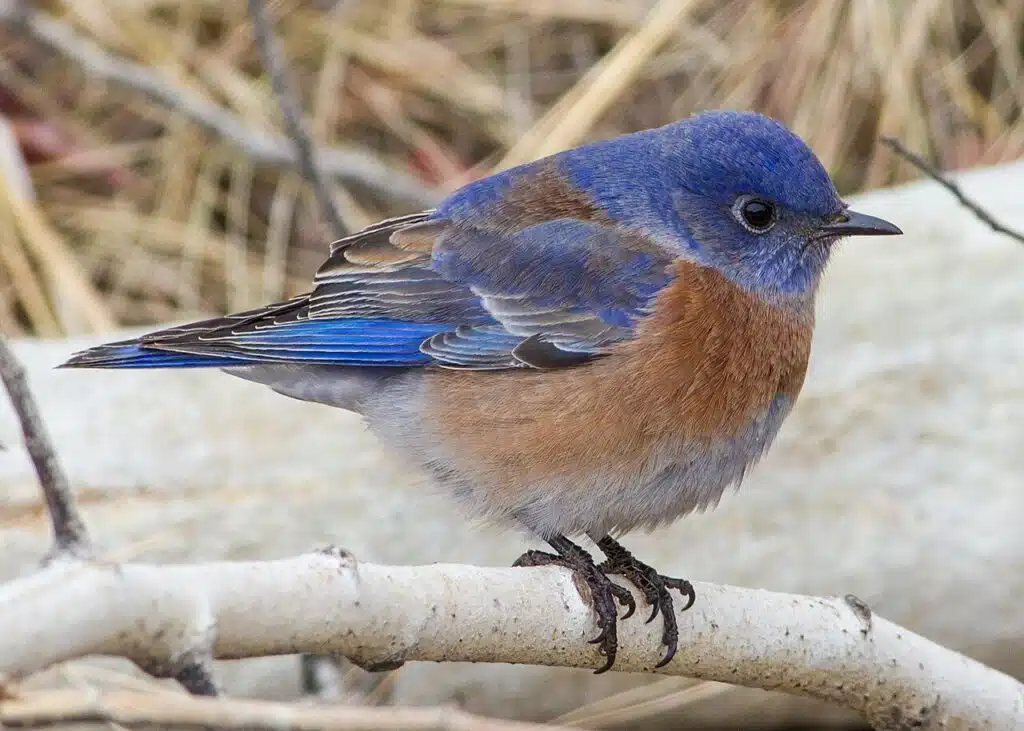
While not entirely blue, The Western Bluebird (Sialia mexicana) is among the most common species with considerable blue plumage in North America.
This is a type of bird found on trees and on the ground. It can feed on bugs and worms one day and catch insects while flying another day.
Its head is blue, as are its wings and short tail. Western Bluebirds have a bright brown chest and an off-white underbelly.
Their legs and beak are both black.
Some subspecies come with small coloring differences such as having a bright gray underbelly.
Distribution – California, Oregon, New Mexico, Arizona, Mexico
5. Tree Swallow
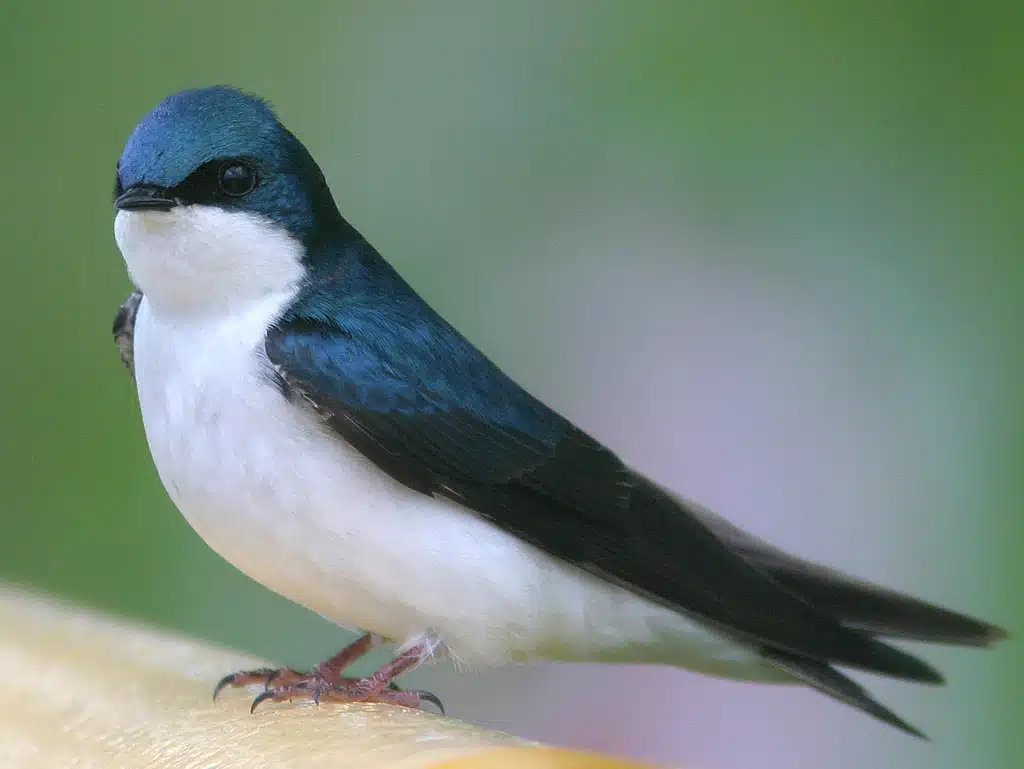
A North American species, Tree Swallows (Tachycineta bicolor) show dark blue coloring in the case of males while females are dull colors.d
A dark blue head is seen on males. Dark and bright blue wings are backed by a dark blue tail.
The chest of the bird and its back have a brown-red color. Gray underbellies and black beaks complete the appearance of this rather dark species.
Blue feathers are seen on the wings of females and juveniles. The female of the species is dominated by gray and brown nuances but also has a blue tail just like males.
Purple nuances are often seen on the plumage of males, but not on the plumage of females.
Distribution – Western United States, Mexico
6. Woodhouse’s Scrub-Jay
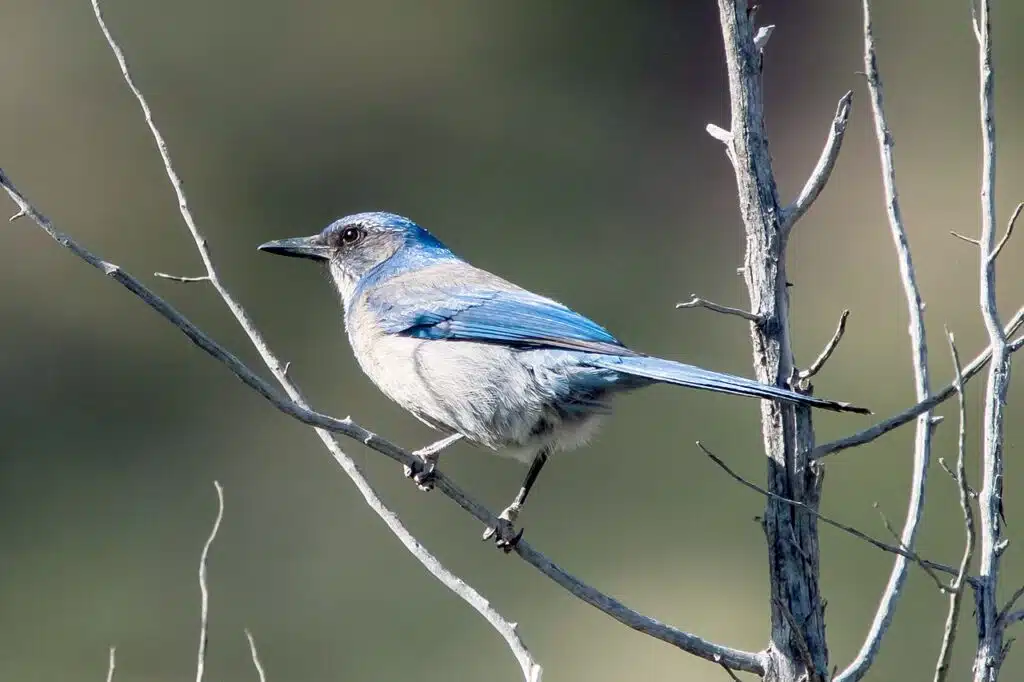
Blue and gray colors dominate the appearance of Woodhouse’s Scrub-Jay (Aphelocoma woodhouseii). This is a species that is sometimes confused with The California Scrub Jay.
Woodhouse’s Scrub Jay is also only present in the Eastern parts of California as opposed to the state-wide distribution of The California Scrub Jay.
Dark plumage separates the species as Woodhouse’s Scrub-Jays are darker blue and have darker gray underbellies.
The blue nuance is also dark royal on these birds.
They have blue heads and wings as well as long blue tails. White and blue sections are seen on the neck while the underparts are dark gray
Distribution – Southwestern United States, Mexico
7. Lazuli Bunting
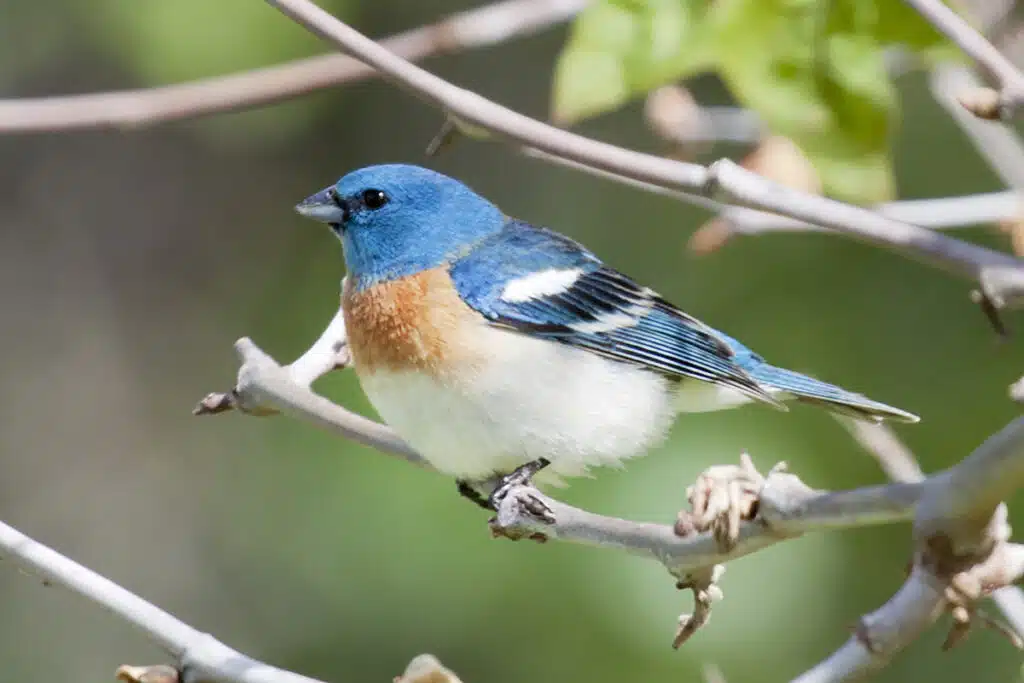
A species similar to Indigo Bunting, Lazuli Buntings (Passerina amoena) are found throughout the Western US states.
A species that may migrate to Mexico outside of the breeding season, Lazuli Bunting has bright blue upper coloring.
Its head, back, and tail are bright blue. The wings show black, white, and blue feathers.
The chest of the species is mostly brown while the underbelly is white.
Females look completely different from males and are dominated by gray nuances.
Outside of the breeding season, male Lazuli Bunting have gray sections on the back but females don’t have any blue feathers.
Distribution – Western United States, Baja California, Mexico
8. Mexican Jay
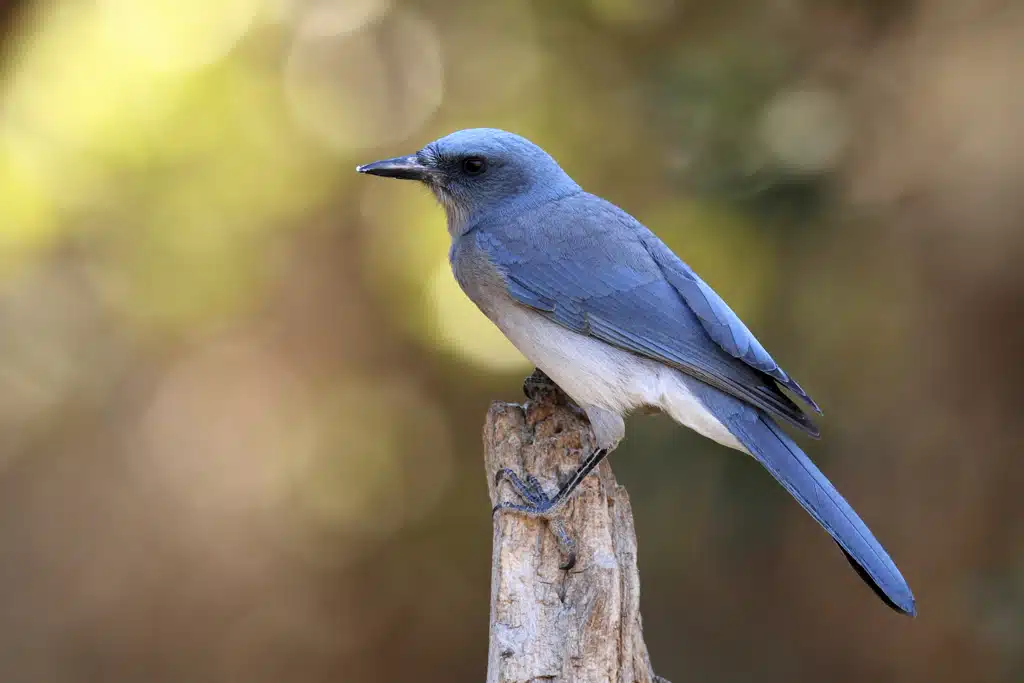
Royal blue plumage dominates the appearance of The Mexican Jay (Aphelocoma wollweberi).
A species of Mexican woodlands and US canyons, Mexican Jays only live in warm habitats.
They are identified by a bright blue head, a dark blue bleak, blue wings, and blue tails.
Dark gray chests and brighter gray underbellies complete the colorful appearance of Mexican Jays.
Distribution – Arizona, New Mexico, Mexico
9. Florida Scrub-Jay
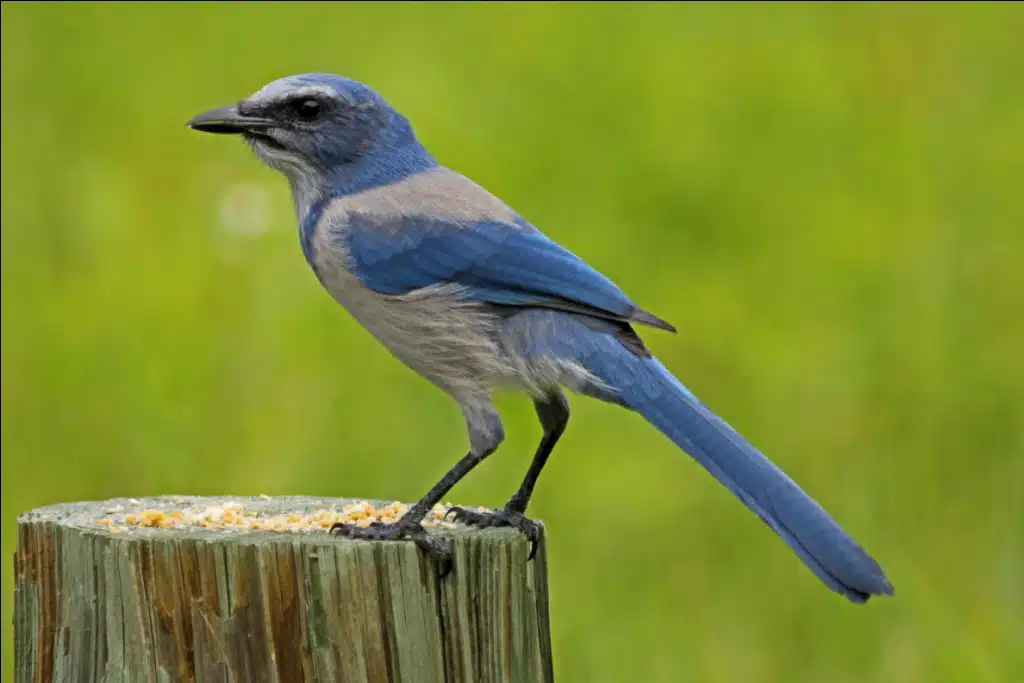
This species (Aphelocoma coerulescens) has a limited range in Florida. Its plumage shows a combination of blue and gray nuances.
The grey neck and underbelly of the species are backed by a blue head and blue wings. This species also has a slightly elongated dark blue beak which helps it catch prey.
Florida Scrub-Jays feed on insects but they can also eat fruits and seeds. These birds have even been spotted eating small rodents.
These birds are further known to offer protection to the young of the species for years, a rare trait in the world of blue and white birds.
This rare trait allows both the parents as well as another adult Florida Scrub-Jays to protect the inexperienced adults from predator birds and other predators.
Distribution – Florida
10. Island Scrub-Jay
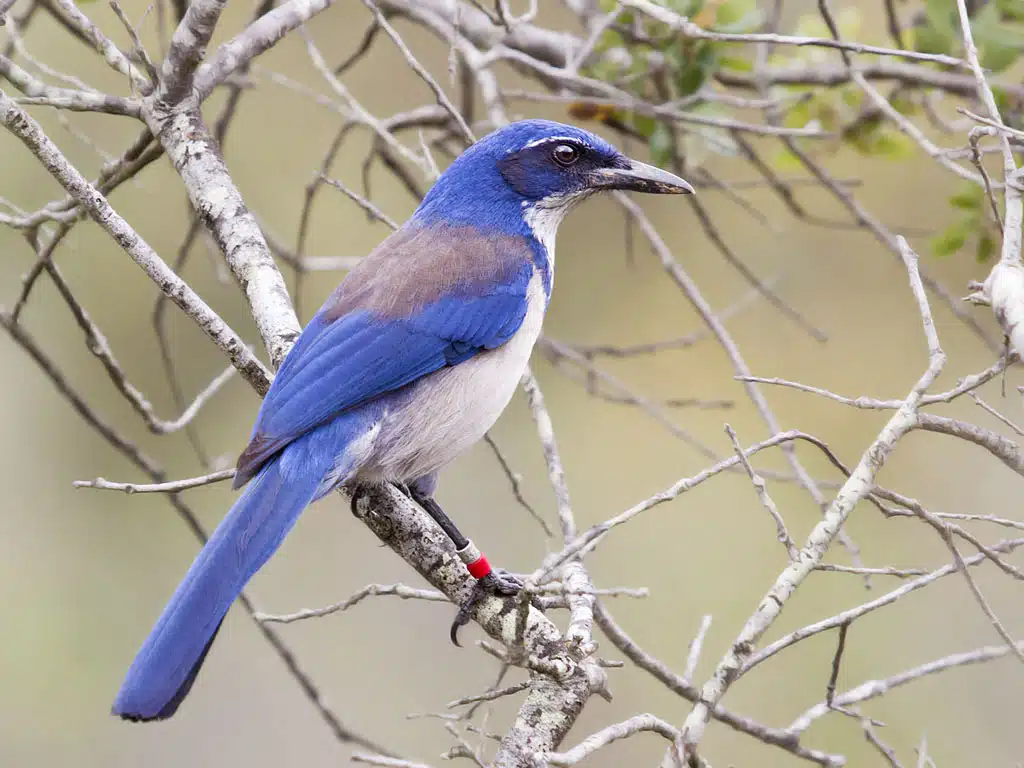
Highly similar to The California Scrub-Jay, Island Scrub-Jays (Aphelocoma insularis) can be differentiated by their longer beaks and their limited habitat.
Island Scrub-Jays only live on Santa Cruz Island. While close to Los Angeles, the island provides an ideal habitat for these birds.
Royal blue colors are specific to the head, back, wings, and tail of the species.
Its neck and underbelly have a gray nuance while its legs are black. The neck section is almost white while the underbelly is darker gray.
As with other blue and white birds, adults of the species also show a gray patch on the back outside of the breeding season.
A species of The Channel Islands, the bird is known for having social behavior. It lives in small groups and it shows a resident status in its native range as it doesn’t migrate.
Distribution – Santa Cruz Island in California
11. Black-throated Magpie-Jay
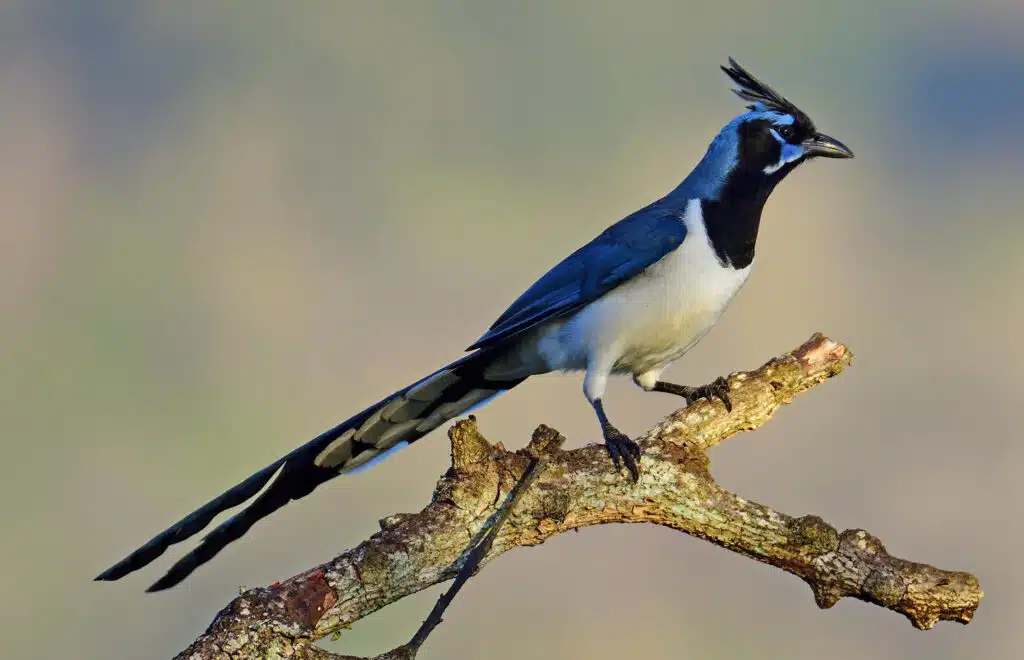
Blue and white colors dominate the appearance of The Black-throated Magpie-Jay (Calocitta colliei). This is a species named after its black mask and black crest.
Only small areas around the eyes are bright blue and white. Most of the back and wings are bright blue while the underside of the species is dominated by white plumage.
A type of crow, The Black-throated Magpie Jay has an omnivorous diet. It feeds on all types of seeds, insects, and leftovers it can find.
Its presence in the Southern US states is sporadic as its range is specific to Western Mexico.
The species can often be spotted on trees, where its very long tail makes it stand out.
Distribution – Mexico
12. Yellow-billed Magpie
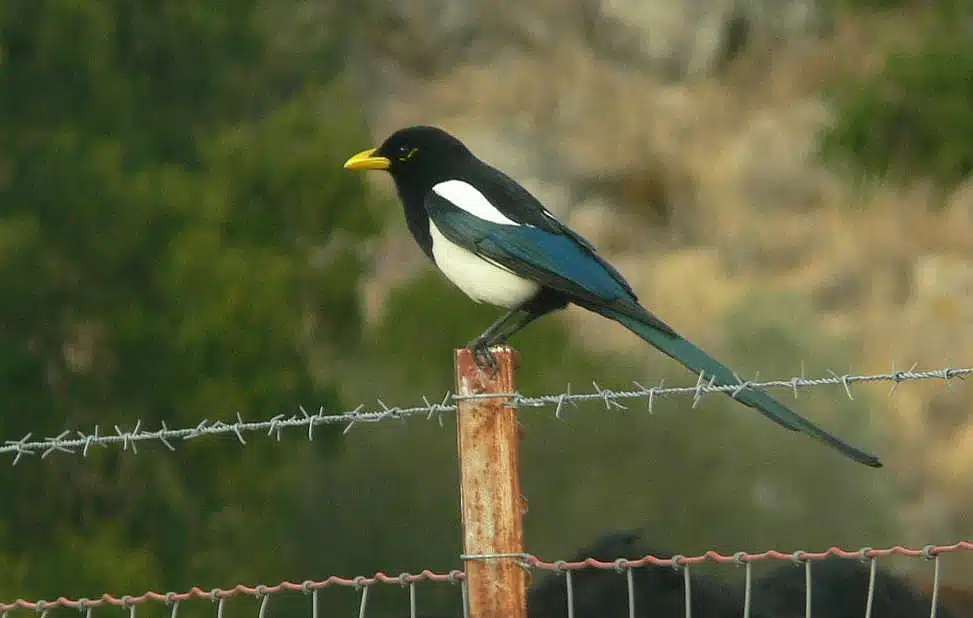
Named after its vivid yellow beak, The Yellow-billed Magpie (Pica nuttalli) is a species with black, white, and green-blue plumage.
The white sections are specific to its underbelly and the base of its wings. Blue coloring with green undertones and a metallic sheen is specific to its wings and tails.
Yellow-billed Magpies also have a black head and a black chest.
Much of their lives are spent on the ground, where they look for food. Insects and bugs are part of their diet, together with some atypical food choices such as carrion.
Distribution – California
13. Mountain Bluebird
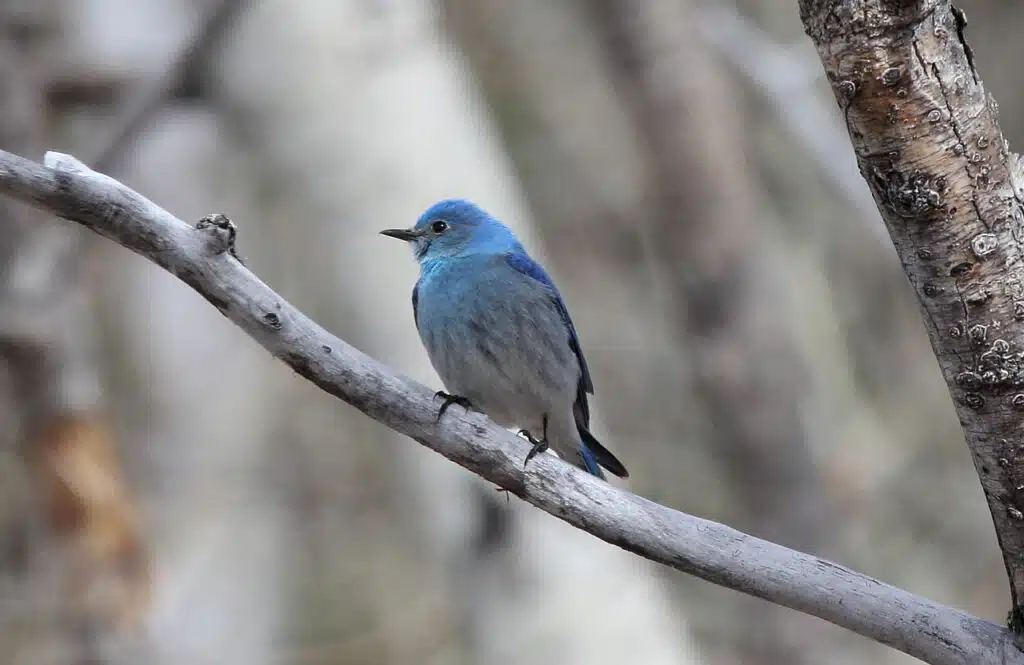
The Mountain Bluebird (Sialia currucoides) is one of the species which has almost a completely blue appearance with a small white section on the lower belly.
This is a species with turquoise-blue nuances of different shades. Its upper parts and its head are darker blue while its chest and upper belly are bright blue.
White sections are only seen on the lower belly and on the tail.
Females have a different appearance. Compared to males, they are mostly gray with bright blue streaks on their black wings.
Distribution – Western North America, Mexico
14. Red-breasted Nuthatch
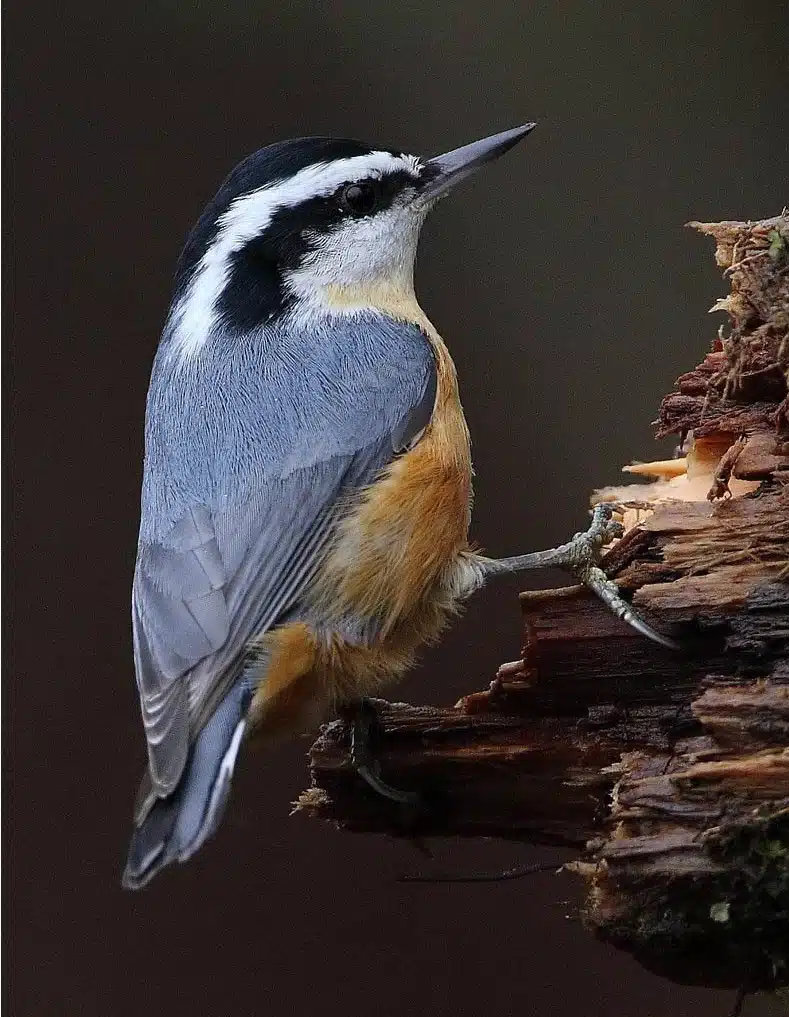
Blue-gray and off-white colors are the trademarks of Red-breasted Nuthatch (Sitta canadensis).
A Canadian native, Red-breasted Nuthatches also move to The United States either for food or to overwinter.
They live in coniferous woodlands where they stand out with contrasting plumage.
Dark blue and white streaks contrast its head. The wings and back are also blue-gray.
This is a species with white bellies or cream bellies and white chests.
Distinct breeding habits are specific to the species. Males lift their heads to show their red necks and chests to females during courtship.
The color of the neck and the belly changes to brown-red on males entering the breeding season.
Distribution – Canada, United States
15. Black-throated Blue Warbler
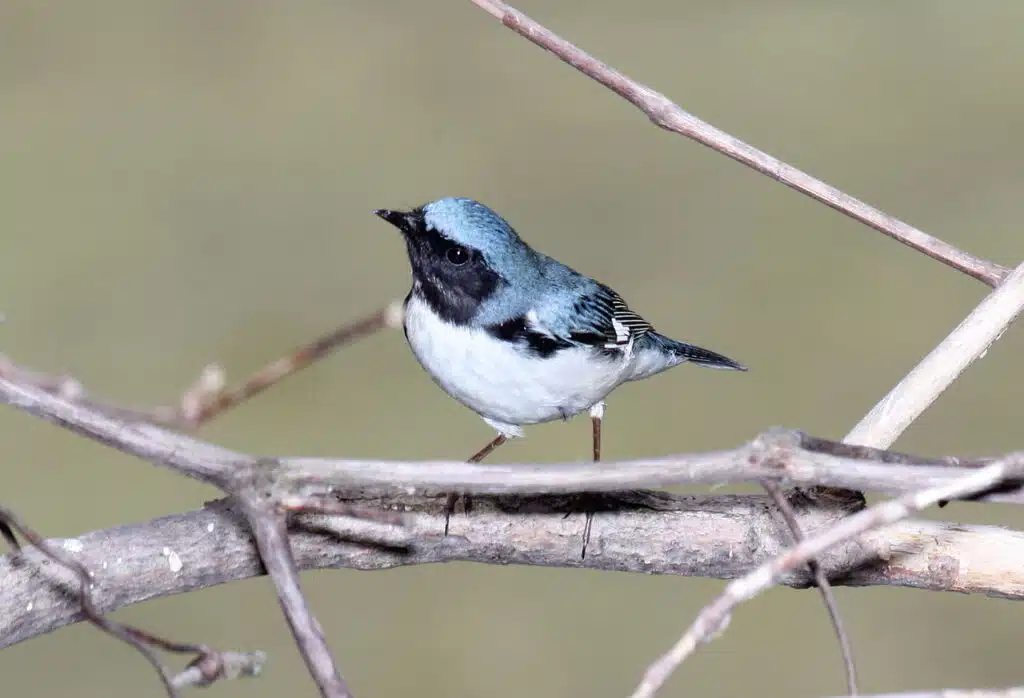
A common white and blue migratory species, Black-throated Blue Warblers (Setophaga caerulescens) are mostly specific to the Eastern parts of The United States.
This bird is also found in Central American countries and in The Caribbean, some of its preferred overwintering locations.
Males and females are dimorphic. Only males are white and blue while females are mostly gray.
The male bird has dark blue crests, backs, and wings. A black neck and face are also seen on males, as the name of the species suggests.
This bird has additional black and white streaks along its wings while the tail is mostly blue and white.
Pure white plumage is specific to the underbelly of male Black-throated Blue Warblers.
Females are gray and brown. They lack blue nuances and may show small white wing streaks and patches once reaching breeding age.
Distribution – Southern Canada, Eastern United States, Cuba, Dominican Republic, Mexico, Guatemala, Costa Rica, Nicaragua